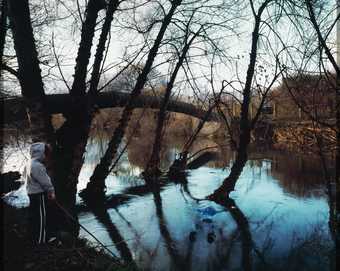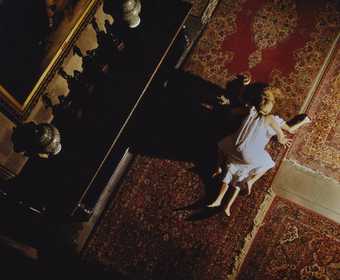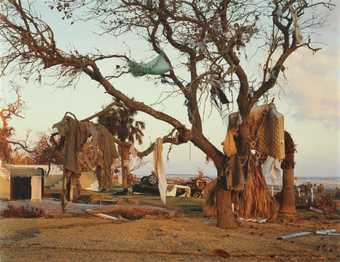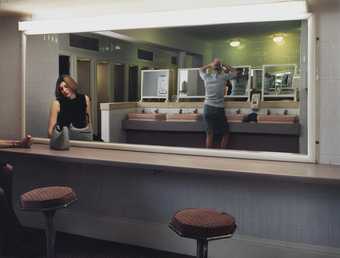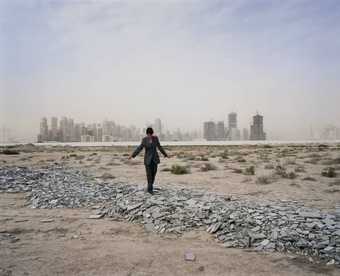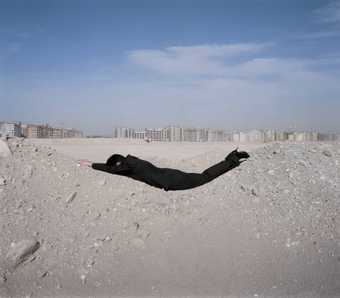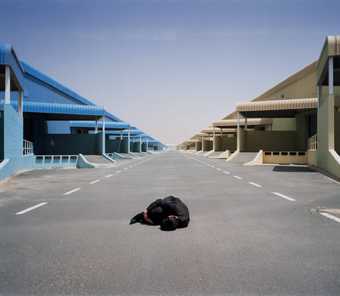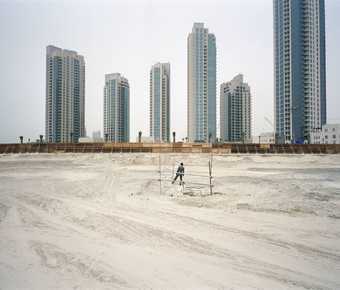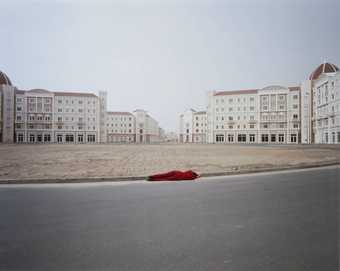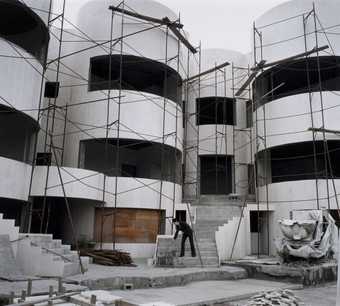
Not on display
- Artist
- Carey Young born 1970
- Medium
- Photograph, colour, on paper mounted onto aluminium
- Dimensions
- Image: 1219 × 1518 mm
- Collection
- Tate
- Acquisition
- Presented by Tate Patrons 2009
- Reference
- P79820
Summary
In this colour photograph the artist Carey Young is depicted lying on her front on a rectangular concrete block at the top of a set of newly constructed steps in a dusty construction site. Young’s upper body hangs over the corner of the block at a sharp right angle with her head tucked in tightly and her hands flat on the ground. Behind the white wooden fencing that curves around the building site stands a series of large beige-coloured towers with cranes visible on the right of the image. No other figures populate the scene, and the fact that Young wears a plain, dark grey business suit and high-heeled shoes only serves to emphasise the peculiarity of her pose in this setting.
This is one of eight photographs from Young’s Body Techniques series, made in 2007. In each photograph the artist wears a smart two-piece suit and is pictured alone in the centre of the image within a landscape featuring recently completed or half-finished construction projects in the cities of Dubai and Sharjah in the United Arab Emirates. The actions that Young is seen performing make reference to artworks from the 1960s and 1970s that explored the relationship between the artist’s body and its surroundings. These art historical citations are acknowledged by the titles of each photograph, which identify the original work that Young’s action re-stages, along with the name of the artist and the date it was first made. Four of the photographs – those referencing Ulrich Ruckriem, Richard Long, Bruce Nauman and Mierle Laderman Ukeles – depict Young in an active pose (such as walking or washing steps), while the other four – this work, the other photograph referencing VALIE EXPORT, and those citing Dennis Oppenheim and Kirsten Justesen – portray her in a more inactive state (lying or curled up on the ground). The photographs can be shown individually, and when all eight are exhibited together there is no prescribed order of display. The Body Techniques series acquired by Tate is number four in an edition of five.
As the title confirms, this work makes reference to Lean In 1976 by VALIE EXPORT (born 1940), a black and white photograph in which the Austrian performance artist is depicted lying on her back on the end of a stone block at the base of a building. EXPORT’s head hangs over the edge of the block looking outwards into the street and her hands are positioned flat on the ground. Two black lines forming a right angle have been added to the photograph that complete a rectangular frame with the artist’s contorted body. This work is part of EXPORT’s Body Configurations series, completed between 1972 and 1982, which features photographs of the artist taking on various bodily formations in urban locations with geometric lines added to the images. Young’s re-enactment of Lean In, in which she contorts her body in a similar way, shares a concern with how the body relates to urban environments, but the historic stone structure featured in EXPORT’s image has been replaced by an example of clean-cut contemporary design in Young’s. Moreover, Young’s business suit, which contrasts with EXPORT’s casual clothing, calls to mind the ways in which corporate culture drives urban development.
The Body Techniques series was produced during Young’s residency at the Sharjah Biennial Artist in Residence Programme. In that it draws attention to the rapid growth of cities in the UAE, stimulated by private and corporate wealth, and pictures an environment in which human life other than the artist’s is conspicuously absent, the series presents a dystopian vision of global capitalism. As the art historian Julia Bryan-Wilson has commented, these photographs ‘depict the architecture of multinational commerce as depersonalized and dehumanizing, futuristic yet dusty projects of progress perverted’ (Bryan-Wilson 2010, p.246). Within this context, Young’s re-enactments of works of art that sought to illustrate the ways in which bodies and environments exerted pressure on each other appear to speak of the agency of art in the early twenty-first century, although the exact meaning of each gesture is left in doubt. As Young herself has explained: ‘it is ambiguous whether the artist is molding herself to the landscape or exploring ways of resisting it.’ (Carey Young, ‘Body Techniques’, http://www.careyyoung.com/past/bodytechniques.html, accessed 14 April 2014.)
Since graduating with a Masters degree in photography from the Royal College of Art in London in 1997 Young, who often appears in her work dressed in a suit, has sought to investigate the role of the artist within a corporate world (see, for example, Everything You’ve Heard is Wrong 1999, Tate T12148). As Young explained in 2011,
The ‘I’ in my work is first and foremost the figure of an artist. The works appear to be self portraits, but they are not autobiographical. I want this figure to represent any artist ... except this is an artist who has half lost their identity, or gained another – perhaps the ‘other’ – to also become what looks like a professional or businessperson of some kind. What I am interested in is the artist as chameleon, and also a kind of non-identity.
(Young and Magid 2011, accessed 14 April 2014.)
The title of the Body Techniques series refers to French sociologist Marcel Mauss’s influential theories of ‘the techniques of the body’, which he developed in the 1930s. Mauss examined how activities such as walking, sitting, standing and sleeping vary not just between individuals, but also between different communities, societies, classes and across historical eras.
Further reading
Julia Bryan-Wilson, ‘Inside Job: The Art of Carey Young’, Artforum, October 2010, pp.240–7.
Carey Young and Jill Magid, ‘The Color of Law’, Mousse, no.29, June 2011, www.careyyoung.com/essays/mousse.html, accessed 14 April 2014.
Raphael Gygax and Heike Munder (eds.), Carey Young: Subject to Contract, exhibition catalogue, Migros Museum of Contemporary Art, Zurich 2013, pp.66–81, reproduced p.69.
Richard Martin
June 2014
Revised by Christopher Griffin
September 2014
Supported by Christie’s.
Does this text contain inaccurate information or language that you feel we should improve or change? We would like to hear from you.
Explore
- architecture(30,960)
-
- features(8,872)
-
- stair / step(514)
- townscapes / man-made features(21,603)
-
- building site(235)
- fence(429)
- tower block(152)
- formal qualities(12,454)
-
- photographic(4,673)
- literature (not Shakespeare)(2,276)
- clothing and personal items(5,879)
-
- suit(301)
- actions: postures and motions(9,111)
-
- lying down(392)
- woman(9,110)
- Young, Carey(9)
- self-portraits(888)
- cities, towns, villages (non-UK)(13,323)
-
- Dubai(9)
- lifestyle and culture(10,247)
-
- high art(60)
- commerce(93)
- globalization(28)
- arts and entertainment(7,210)
-
- artist, multi-media(393)
You might like
-
Tom Hunter Gangland Execution Boys Find Man’s Body in River
2003 -
Anna Gaskell Untitled #47 (Hide)
1998 -
Rut Blees Luxemburg Tyson/Bombardier
2003 -
Mitch Epstein Biloxi, Mississippi 2005
2005 -
Hannah Starkey Untitled - March 1999
1999 -
Hannah Starkey Butterfly Catchers
1999 -
Dan Holdsworth A Machine for Living: Untitled
1999 -
Carey Young Body Techniques (after A Line in Ireland, Richard Long, 1974)
2007 -
Carey Young Body Techniques (after Parallel Stress, Dennis Oppenheim,1970)
2007 -
Carey Young Body Techniques (after Sculpture II, Kirsten Justesen, 1969)
2007 -
Carey Young Body Techniques (after Encirclement, Valie Export, 1976)
2007 -
Carey Young Body Techniques (after Circles, Ulrich Ruckriem, 1971)
2007 -
Tracey Emin Monument Valley (Grand Scale)
1995–7

